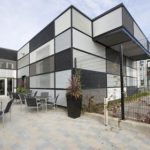
AODBT Office Renovation is an example of Thurston Engineering Services’ status as experienced energy modellers: Thurston was brought in to model the award-winning building system post-review. Essentially, it was our job to look at modelling conundrums that technical assistance and a previous reviewer could not solve.
Service completion: Fall 2012
Scope of services: Optimize Energy Performance Simulation (EAc1) for CaGBC LEED: New Construction 1.0 with addenda
Size: 14,000 sq.ft.
Building systems: Metal-clad exterior on insulated concrete block and wood framing, RadLink combination forced-air heating/cooling system and radiant wall heating, efficient lighting with some occupancy sensor control.
With the renovation project, there were limitations with this construction along with a desire to be a showcase in interior design and in energy design. While the owner was comfortable using a simple traditional forced air furnace system in the small building, perimeter comfort was a concern. As a result, the RadLink system was introduced where the forced air furnaces provided heating and ventilation, but also generated hot water for perimeter heating—saving on initial capital over a boiler system, and saving on much future operating cost over the electric baseboard alternative. This required splitting heating into the “air handling unit” forced air portion, and into a “boiler” for radiant heating. This did not yield savings over the simplistic modeling of putting all energy in the “air handling unit”, but it did solve modeled under-heating issues and increased the accuracy of the model. Savings were achieved in accounting the variable speed capability of the furnace fans, where the fans were in low speed with low heating or cooling load, and ramped up with load. This is not modeled with traditional variable speed systems, so a manual calculation of savings was required.
In addition to those significant changes, the accuracy of the model was improved upon initial review to account for designed fan static pressure, to account for the electrically heated zones, and to account for the pumping of the RadLink system. The end result was a more accurate model at 34% better than MNECB with respect to cost, achieving 2 more points than the initial review.
Back To Portfolio